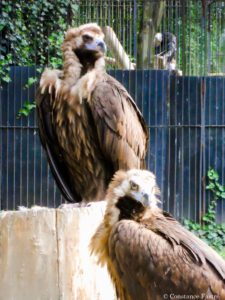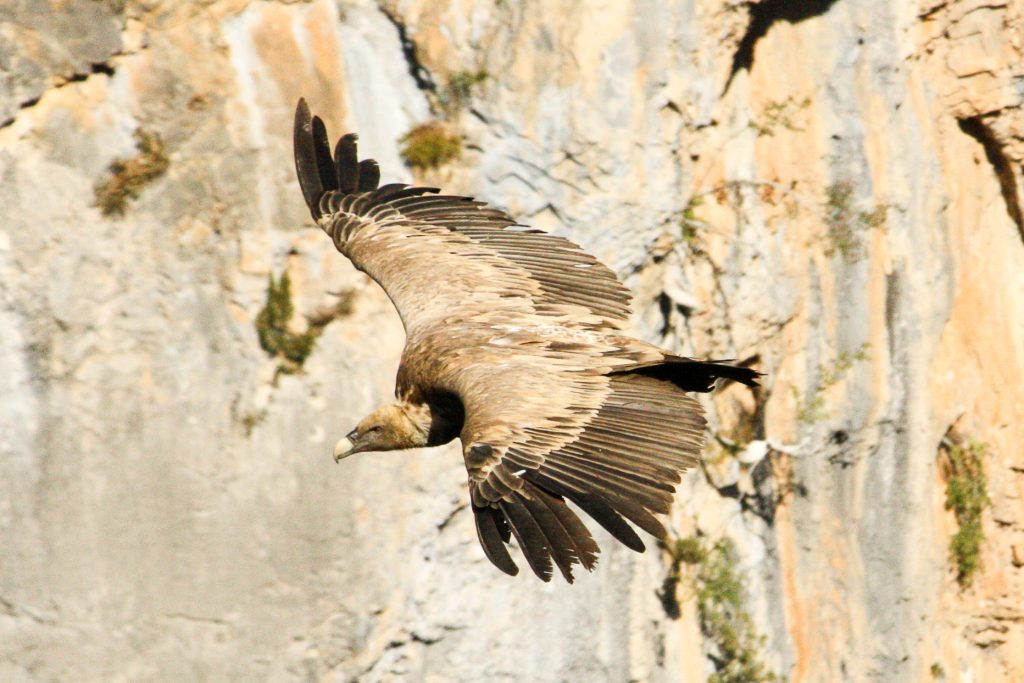I’ve had a sweet spot for vultures since I studied the breeding behavior of a pair of Cinereous or Black Vultures (Aegypius monachus) at the Zoo of Antwerp during my master’s degree. As I observed this adorable couple and learned more about vultures in general, I realized how incredibly beautiful, useful and, sadly, endangered these birds are.

Due to persecution and poisoning, vultures were almost wiped out from most of Europe and North America as early as the 19th century and are now heavily threatened in Asia, Africa and South America. As a result, 14 out of the 23 species of vultures existing in the world today are currently threatened with extinction.
The reason why vultures have been – and still are – persecuted worldwide is mainly because people dislike their appearance and their habit to feed exclusively on rotting meat. Even Charles Darwin claimed that vultures were ‘disgusting’! Such a dislike is unfortunate because by eating carcasses, vultures clean the environment and play an important role in preventing the spread of diseases. In addition to being useful, vultures are truly fascinating animals: they are among the largest flying birds on Earth, have such acidic digestive systems that they can eat decaying meat without getting ill and have an extremely powerful eyesight allowing them to locate dead animals from high up in the sky.

We were keen to see vultures in the wild, so we decided to spend our second holiday together in one of the places in Europe where there are still many vultures: the Spanish Pyrenees. Four species of vultures occur in Europe: the Egyptian Vulture (the smallest species, Neophron percnopterus), the Cinereous (or Eurasian Black) Vulture (Aegypius monachus), the Bearded Vulture (also called Lammergeier, Gypaetus barbatus) and the Griffon Vulture (Gyps fulvus). The latter two species, which are the largest of the four, are also the most common and therefore the ones we were most likely to see.


Bearded vultures with their golden feathers and their long bristles on the face, are beautiful birds. They also have evolved a fascinating behavior that allows them to feed on parts of the carcasses other predators and vultures usually leave aside: the bones. Bearded vultures pick up bones, take them up in the sky from where they drop them onto rocks to break them and access the very nutritious bone marrow. We started our search for the Lammergeier in the Ordesa y Monte Perdido National Park. Walking around the valley of Ordesa looking for vultures was delightful: thanks to its limestone massif (the largest in Western Europe), the park has incredible views.

As we walked in the valley of Ordesa, we noticed we were being watched from afar by two Pyrenean chamois (Rupicapra pyreanica). This species only occurs in a few areas of Spain, France, Andorra, and Italy and there may be as few as 50,000 of them in the entire world! They are very difficult to distinguish from the much more widely distributed Northern chamois (Rupicapra rupicapra) by sight, but as they never occur in the same location, you can always know which one you have seen. We had fun watching the chamois watching us for a few minutes before they disappeared behind the hills then continued our beautiful hike.

Finally, after two unfruitful days looking for the vultures, it was the receptionist of our hotel that led us to the Bearded vultures. As we looked up to the top of the neighboring mountain that she pointed out to us (and later turned out to be called Punta Siarra Casas), we could see three small black dots hovering around it: a breeding pair of Bearded vultures with its young. We immediately drove to the foot of the mountain and started climbing, our eyes fixed upon the birds, hoping they were not going anywhere before we got a good look at them. Two hours later, we reached the top and there they were, closer than we had ever hoped to see them, so large and majestic!

After this fantastic encounter, we wanted to see more vultures, so we headed to a viewpoint in Escuain. From our outlook, we were perfectly located to watch Griffon vultures soar the thermals between the ridges. Griffon vultures are even larger than their bearded brothers, making it a pure enchantment to see such impressive animals shoot up in the sky effortlessly.


Our ornithological instincts quite satisfied, we moved on to the last destination our trip: the Aïguestortes i Estany de Sant Maurici National Park. The park, famous for its high mountain lakes which cover almost 15% of its entire surface and the twin peaks of the Encantants, is a paradise for hikers. As we walked from lake to lake and engorged the natural beauty of the area, we spotted several Griffon and Egyptian vultures high in the sky. The Red crossbills (Loxia curvirostra) fluttering around the fir trees scattered in the rocky landscapes were the cherry on the cake of this truly amazing trip in the Spanish Pyrenees.




Most of the scientific information on the different vulture species of the world were taken from Ogada et al., 2011, available at: https://assets.peregrinefund.org/docs/pdf/research-library/2011/2011-Ogada-vultures.pdf

